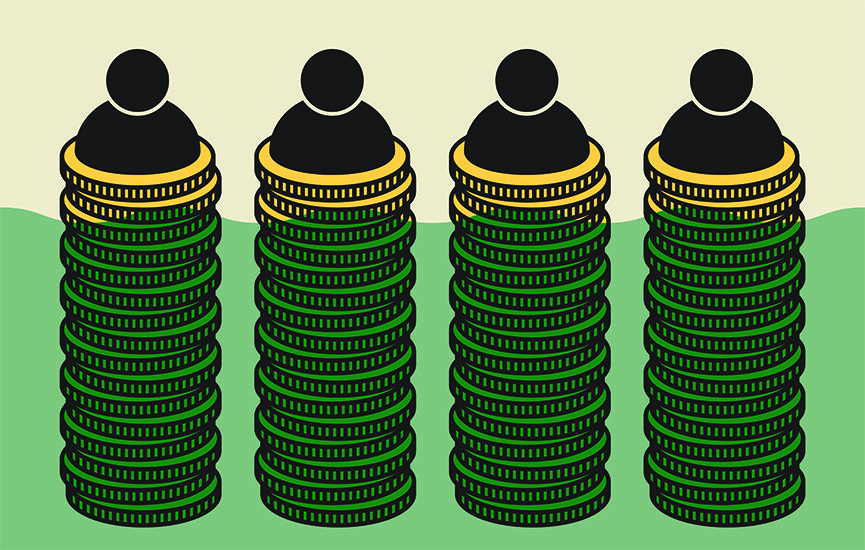The World Economic Forum issued at report at Davos in January estimating that new developments in AI would put 5.1 million people out of work in 15 of the world’s leading economies by 2020. How those 5.1 million unemployed people will react is an open question, but a populist revolt would not be historically unprecedented. The rise of anti-globalization demagogues like Donald Trump and Boris Johnson already has demonstrated the dissatisfaction of many with the 21st-century economy. One proposed solution to the labor disruptions caused by AI is Universal Basic Income, the idea that people should be paid by the government simply for existing.
“It would be a guaranteed floor, in amounts of money, where no one’s going to be in poverty. And then it would be up to the people what they want to do from there. They can work. They can not work,” says Matt Krisiloff, who is heading up a research project on UBI for legendary tech incubator Y Combinator. Y Combinator is at the forefront of Silicon Valley’s embrace of UBI and is running a pilot program in Oakland, Calif., in which 10 to 15 people will begin receiving payments of between $1,250 and $1,666 each month, starting in August or September. The pilot will run for one year and a larger, national five-year study is planned.

Since 2005, Y Combinator has invested in and helped develop more than 940 companies, including Zenefits, Airbnb, Dropbox and Twitch.tv, and it’s been one of the largest contributors to the explosion of wealth in the Bay Area. “We’ve seen a lot of companies go from two-person teams to multibillion dollar companies. We think there’s a decent likelihood that that’s going to, over time, increase the number of startups… and the amount of wealth being created,” particularly as a result of artificial intelligence, Krisiloff says. “We think we could reach a point where there’s a high degree of automation and a much higher degree of wealth than we have now, too.” Those conditions, Krisiloff contends, would require “a greater social safety net for people and a better minimal level of security. [Using UBI] we really can redistribute resources in a way where everyone can have access to them.”
It’s estimated that UBI payments of $13,000 per year to Americans over 21 years old would cost around $3 trillion, essentially all federal tax revenue. UBI proponents say a basic income would also free low-wage workers to negotiate more aggressively, help support the millions of workers moving in the freelance and “gig” economy. Paradoxically, for UBI to be economically feasible, monthly payments would probably have to replace most of the safety net provided by the government today, support like food stamps, Social Security, Medicare, Medicaid, farm subsidies and housing assistance, a concept that appeals to Libertarians. Those on the left see UBI as a tool for income redistribution.
“There’s a tremendous amount of intrigue both on the left and on the right,” says Krisiloff. In Silicon Valley, elites including X Prize creator Peter Diamandis, ZipCar CEO Robin Chase, venture capitalist Marc Andreessen and Tesla principal engineer Gerald Huff all support UBI. Regardless of the ideological origin of the idea, these are essentially utopian arguments for basic income. But not everyone is as bullish on UBI as the tech community seems to be.

“There’s very little support [from] the economic experts,” says Steven Kaplan, the Neubauer Family Distinguished Service Professor of Entrepreneurship and Finance at the University of Chicago’s Booth School of Business. The IGM Economic Experts Panel, in fact, found that 84 percent of surveyed economists either disagreed or strongly disagreed that UBI payments would be an improvement over the current safety net. And only one percent of surveyed experts felt that UBI would be an improvement over the current system. According to Kaplan, “the reason there’s interest in UBI now,” despite the pessimistic consensus of economists, “is that there is a worry—bigger among tech people than others—that because of technology and particularly AI… there are going to be no jobs or fewer jobs, and to the extent there are jobs, they are low paying. And the people who do the programming are making a lot of money.”
The advent of AI is not the first technological disruption of the labor market. When the industrial revolution was just beginning to ramp up in England, one of its most disruptive technologies was the power loom—invented 1784—which could rapidly weave fabrics. Power looms vastly improved efficiency, just as AI and robotics are today. One worker could operate up to 30 power looms at a time, which endangered the jobs of textile makers who had been weaving textiles by hand for centuries. These workers, allegedly inspired by one Ned Ludd, staged a series of protests, smashed looms and harassed business owners in an attempt to protect their jobs. The protesters were ultimately unsuccessful, but their actions have reverberated through history: laborers, if they feel they are being replaced by technology, are more than capable of rebelling against the businessmen who put them out of work.
Now, in the 21st century, “the concern among technologists is that income inequality gets worse,” Kaplan says. “That is partially the source of the unrest in the U.S. and globally in the middle class, where less-skilled people have not done—or feel they haven’t done—well with globalization and technological change.” Ultimately, Silicon Valley is looking for a way to redistribute wealth because “they’re worried about the revolution. They’re worried that you get a populous—an underclass that’s very unhappy—who do things that are very bad.”
So while the tech industry promotes UBI as a solution to poverty with bipartisan support, it may really be an attempt to thwart a modern day workers’ revolution. It’s not unlike the ancient Roman emperors’ use of bread and circuses—meaning sustenance and entertainment—to pacify a restive population. Except in the case of Silicon Valley, it’s a monthly check and social media.







